| Report Type | Full |
| Peak(s) |
Pyramid Peak - 14,029 feet |
| Date Posted | 08/12/2018 |
| Date Climbed | 08/11/2018 |
| Author | daway8 |
| Pyramid Pointers |
|---|
|
I’m writing this report mainly to give a few pointers that may be missed elsewhere plus to add emphasis to some important notes others have made as well as to give a few comparisons to other peaks, which is something I wish more people would do. 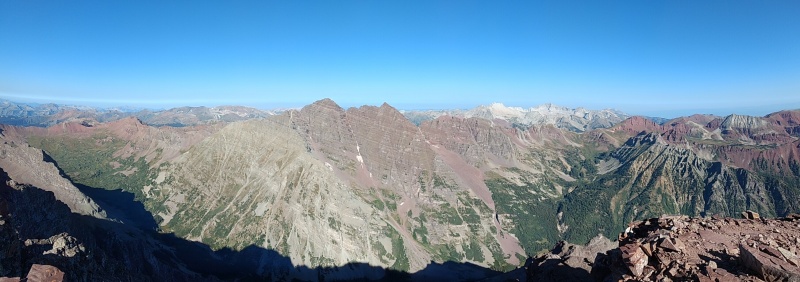 View from summit First some comparisons: Pyramid vs. the Crestones Difficulty of approach: The 1k climb to the ridge on Pyramid felt rather similar to Broken Hand Pass on the Crestones – lots of scree but if you walk where the masses have walked the worst of the loose stuff has already been knocked down. But BHP is nowhere near 1k tall so get ready for a long slug up. Difficulty near summit: The final stretch to the summit was very similar to Crestone Needle in terms of challenge except that Pyramid has sharp, loose rock as opposed to the more solid and knobby rock of Crestone Needle. Both peaks have pretty serious class 3 with the possibility of hitting isolated class 4 moves, especially if you stray off course a little. Like many others I didn’t feel Pyramid was really a class above Crestone Needle unless maybe you consider the loose rock and the “feel” of the peak – see exposure notes below. Exposure: The worst exposure on Crestone Needle is going up the gullies where the gully walls give you at least an illusion of less exposure as they partly wrap around you. The final stretch up Pyramid probably has a pretty similar exposure based purely on steepness but there is no gully so the exposure is totally wide open and therefore visually far more intimidating, especially on the way down. I didn’t really notice it on the way up but when I looked over the first steep section coming down my eyes about popped out. It wasn’t all that bad to come down just visually a little shocking in a spot or two. Route finding: The Crestones and Pyramid both have routes that are pretty trivial to follow even in the dark at the start. For the Crestones you might lose the trail near the lake if it’s dark; for Pyramid it’s really easy to accidently head to the Bells when hiking in the dark. Crestone Needle has the gully crossover that’s easy to miss but after that there aren’t too many options to go off course; on Pyramid the entire final climb to the summit offers endless chances to stray off the course and into spots where you might need some class 4 moves. Pyramid vs. Longs Peak: Difficulty: I felt Pyramid was notably more difficult overall except that it’s a much shorter route than Longs. Note however that it has much of the elevation gain of Longs (4,500 vs. 5,100) and also note that it starts off much flatter than Longs. That means you’ll look back wistfully at how short and easy it was to hop up the Trough on Longs, lol (since Longs was my first summit, for a very long time the Trough held the title of the most excruciating section on any peak – I’m learning there are worse things out there). Exposure: The classic benchmark for exposure is the Narrows on Longs Peak. At 44 peaks and climbing (pun intended) that still is the unrivaled champion of most dramatic exposure along any 14er route (but stay tuned as I’m getting ready to tackle Capital and find out for myself how the infamous Knife Edge compares). Pyramid has a section (the Ledges) similar to the Narrows and is actually even slightly more narrow than the Narrows in one little spot. But the difference is that a fall off the Narrows has an extremely high chance of being fatal while the drop off the Ledges is perhaps 10-15 feet and the Narrows also stretch on notably longer than the Ledges. The ledges also start with a “Leap of Faith” over a 10 foot drop that interrupts them but you can step right over it if your legs are long enough. The Narrows made me slightly uncomfortable (I’m not really afraid of heights) but on the Ledges I played around for 10 minutes or so trying to capture a dramatic looking selfie (it has solid handholds as well as a totally flat surface for your feet so it’s pretty safe and easy to “play” a little on this section if you’re reasonably cautious). Unless you have a really bad fear of heights the Ledges will probably not be any issue for you. Views: The views atop Pyramid are some of the best I’ve seen on any summit – so much dramatic variation in colors, shapes, etc and with multiple other 14ers in easy view (such as the Maroon Bells, Snowmass, and Capitol – with a clear view of its infamous Knife Edge). Pointers: Parking: Parking has the potential to be a real issue, especially on the weekend and especially if you prefer to do peaks as day hikes instead of camping expeditions. The overnight lot is VERY small and there is not an option to just park in the dirt or along the road or such as you can for a majority of the 14ers (i.e. ones that aren’t in the heart of tourist territory so you only have to contend with hundreds of hikers – aka Bierstadt – as opposed to thousands of tourists). But, as others have noted, the “lot full” signs seem to be left up 24/7/365 so I ignored them and arrived at around 10pm on a Friday and found a couple spots open in the main overnight lot near the trailhead (did not check the overflow lot). But the lot was full soon after and most likely stayed that way until the next afternoon. Don’t set your heart on these peaks (Pyramid and the Bells) without a backup plan in case you can’t park when you arrive. 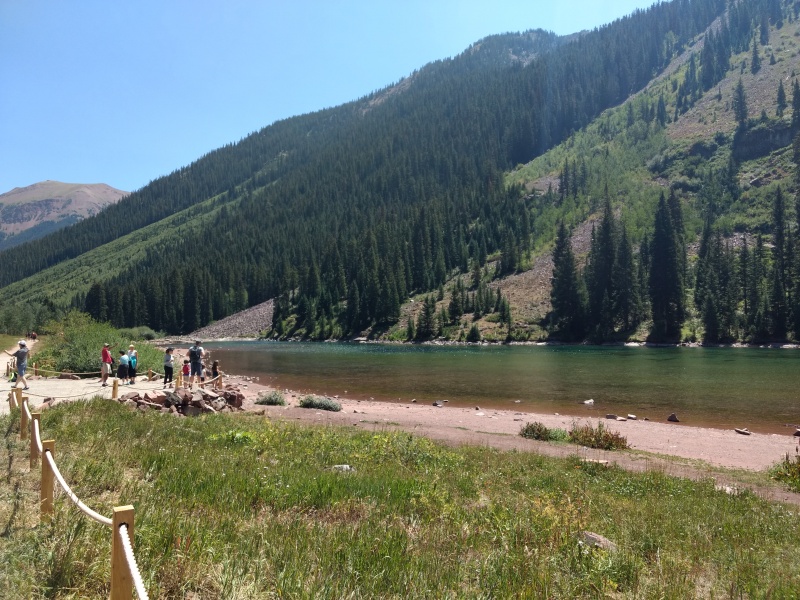 Roped off Maroon Lake Crowds: Even starting before 3am there were more people on this trail than I recall noticing on any other early morning trek I’ve done. Maybe it’s partly the flat open nature of the start where lots of the trail is in view when you eventually start to climb but there were so many headlamps visible that you could have almost sat up high and played connect the dots to map out the trail. Nowhere near as bad as Bierstadt on a summer day but lots more people than when I did Wetterhorn and Uncompahgre with later start times. And of course if you’re coming down in the afternoon, as you start to get near Maroon Lake you’ll think that Bierstadt was a place of wonderful solitude. I was bummed to see Maroon Lake is now roped off so you can’t go down to the water like in days gone by (the most popular places always suffer as a result of their own popularity). Trail: As noted before, the spot where the trail for Pyramid splits off from the Bells is very easy to miss in the dark and even once you start on it there is a social trail that again branches off towards the Bells. I had to pull out my GPS and keep it in hand for a while until I was sure I was solidly on course for Pyramid. 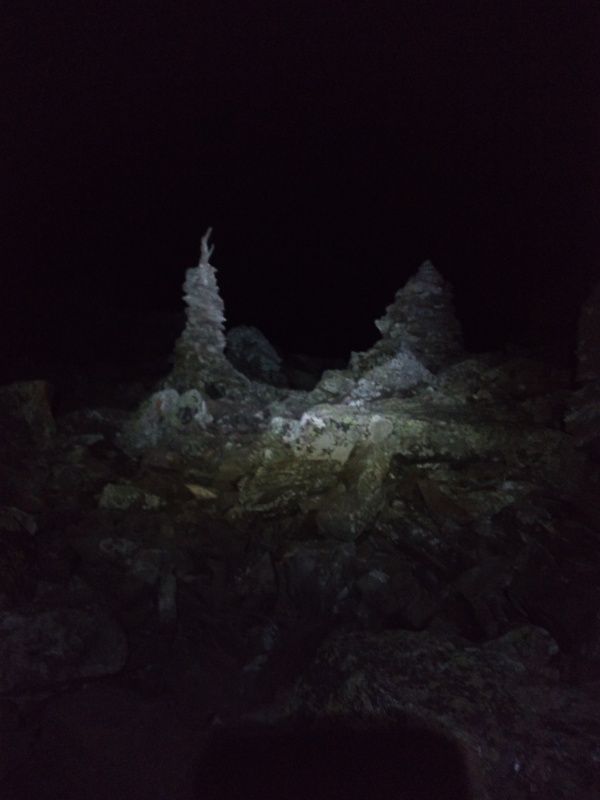 Cairns at entrance to Amphitheatre The entrance to the Amphitheatre is easy to find even in the dark thanks to the enormous cairns as you first come into it but as for a trail, I just followed the lowest point in the middle up to where you turn left and that worked fine (on the way back I realized there is an actual trail for much of it that’s on the climbers right but I don’t know that I’d bother looking for it in the dark). Bring a good strong headlamp and you’ll be able to see the cliffs on either side of you which makes it easy to be confident you’re on the right trek. On the way up in the dark the Amphitheatre felt like it took forever to get through but on the way down it was a rock hoppers heaven. Once you get to the spot where you turn left (again pretty obvious because of the cliffs around you) I blundered around a bit staying more or less in the middle. Some folks in front of me started the 1k climb in the dark and went pretty much right up the center, underneath what looked to be the low point of the ridgeline above. But after a while I heard massive rock fall and someone calling out “don’t come this way, this is getting pretty sketchy!” This is when I decided to take a few minutes near the bottom for a snack break, put on my helmet and wait for the slowly appearing sunlight to increase a little. I found a well-worn dirt trail off to the left of center and found that by following that up most all the loose stuff was already knocked off by the thousands of folks who had walked up it over the years so it wasn’t nearly as bad as the spots in the middle where people were starting landslides. The trail was much easier to spot on the way down than the way up but if you’re knocking down a bunch of stuff you’re probably not on the trail. There was one spot near the top of this section where there was clearly a dirt section going straight up (left side of photo) but there was a somewhat worn section angling up to the right. Since the trail on the ridge cuts to the right I opted to go to the right. I made it without knocking down anything of significant size but it would have been 10 times easier (and ultimately probably faster) to stay to the left on the dirt trail which, though steep and slightly slippery, didn’t have nearly as much rockfall danger as the “shortcut” to the right. 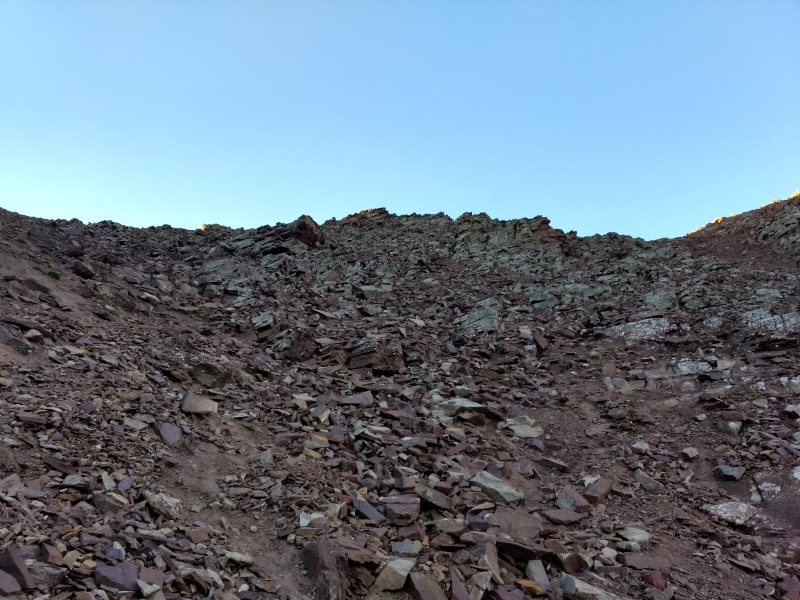 Split near top of 1k climb (staying left on the dirt is much more solid) As for the final climb to the summit, not long after the fun but trivial “Leap of Faith” and Ledges, on the way up I was having trouble spotting the trail and more or less followed the advice seen online of going up the solid rocks to the climber's right of the green wall. This worked ok for a while but it wasn’t long before I started hitting more and more class 4 moves along there. If you like that sort of thing that may be a good route for you. If not, go on over to the green wall and search until you find the trail. On the way down it was much more obvious than the way up but I was still happy to follow some others down so I didn’t have to worry about route finding (thanks Collin!). The tales of mountain goats on this peak are not exaggerated – it was a new record in sightings for me – several of them on the summit even, and not at all shy unless you move quickly towards them. I took literally hundreds of photos of the mountain goats – I put in just a few to give you some idea. 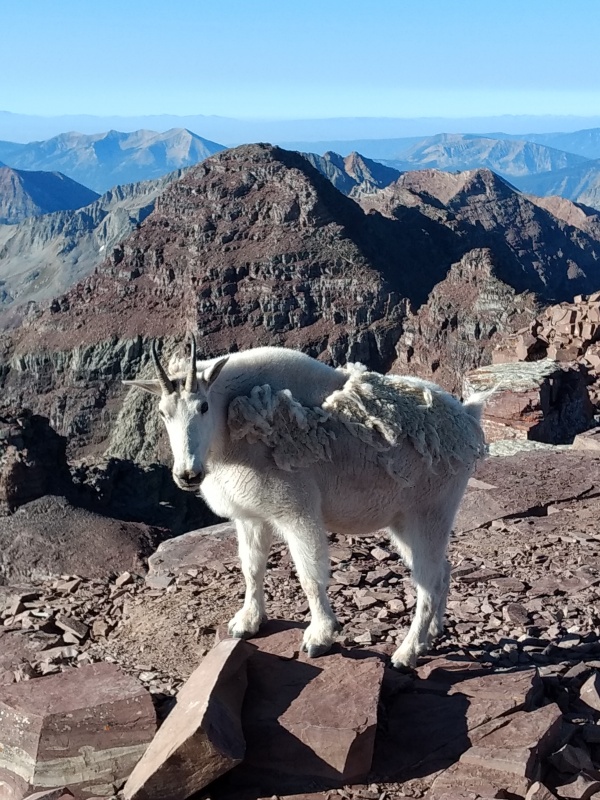 One of the mountain goats on the summit 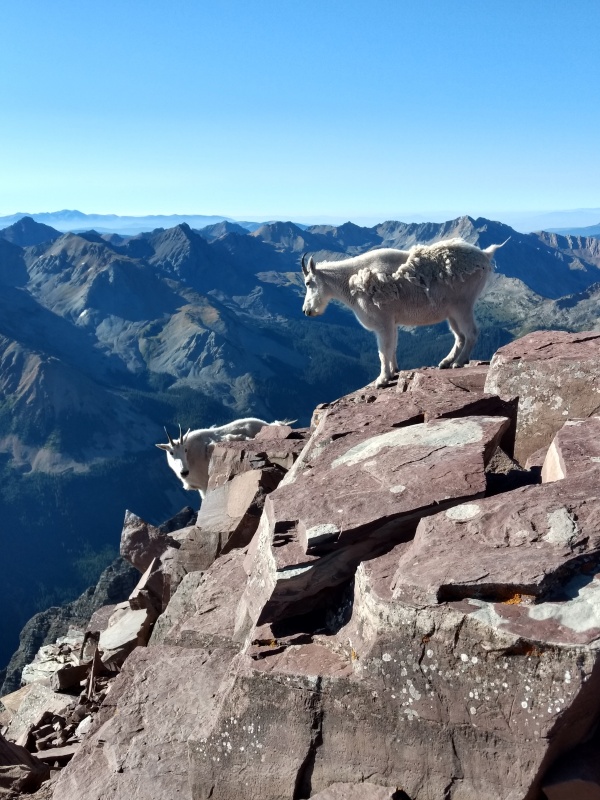 The lower guy got butted off the peak 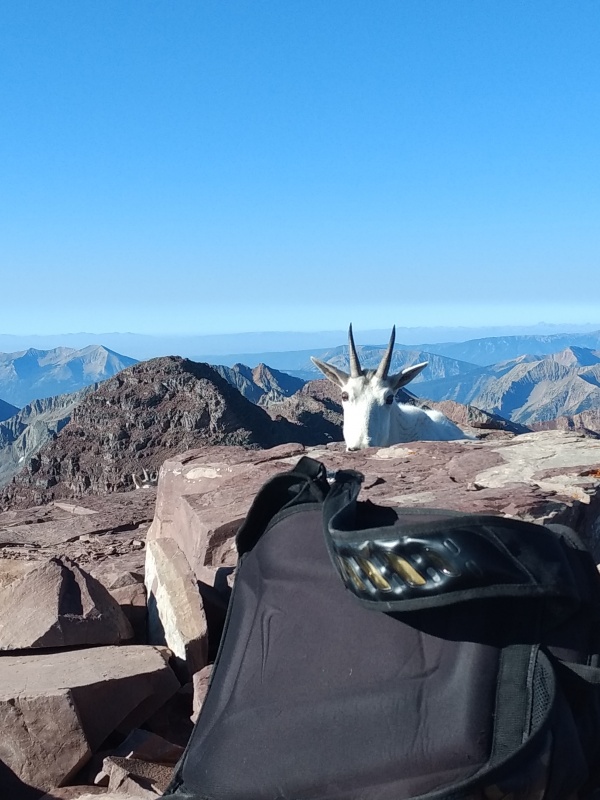 Peekaboo 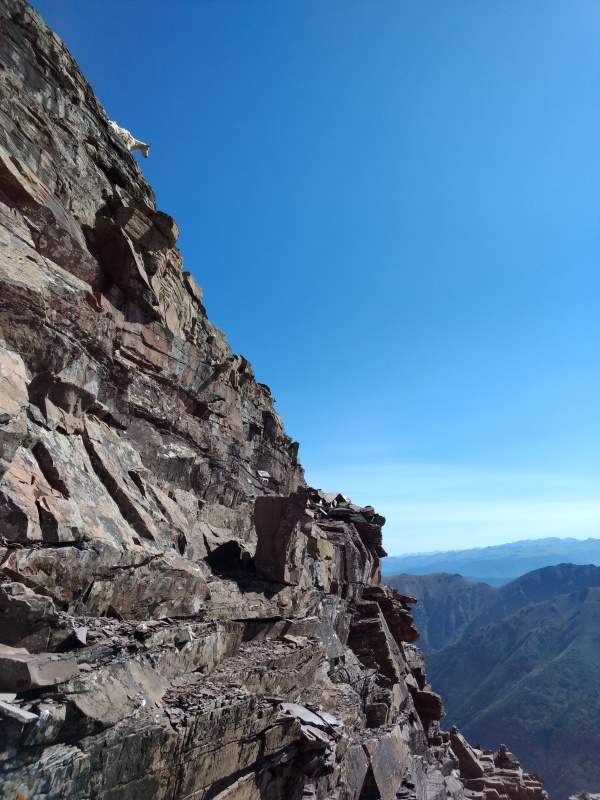 Finally, if you haven’t already done Pyramid and are seriously thinking you might do all the peaks, tuck away in the back of your mind that Pyramid offers an excellent spot for a Finisher photo. Guess I’ll have to settle for something else when I get there – hopefully next summer at the rate I’m going, unless Capital proves too much for me – and I hope to find that out in the next week or two. These far away views of the Knife Edge makes it look pretty impressive but so far I’ve been finding a lot of things look more intimidating at a distance than once you actually tackle them. 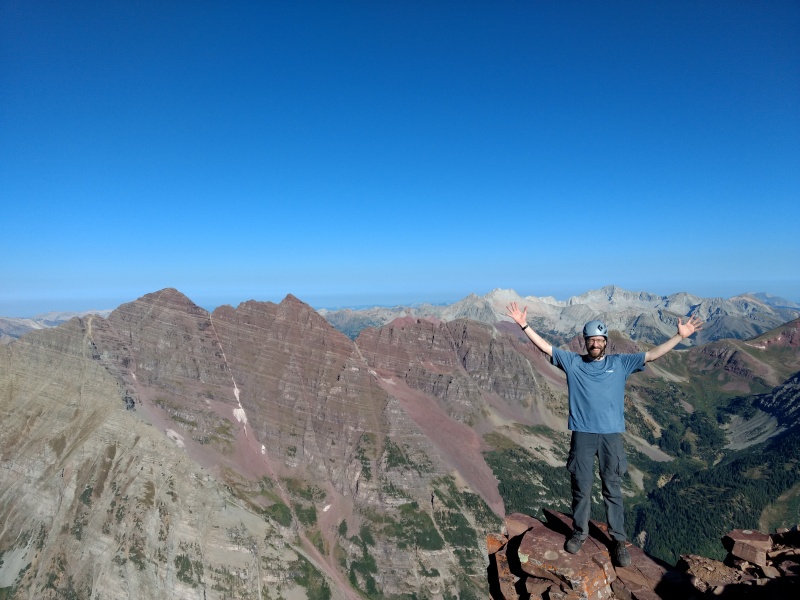 This would have made a great spot for a Finisher photo, but still have 14 left… 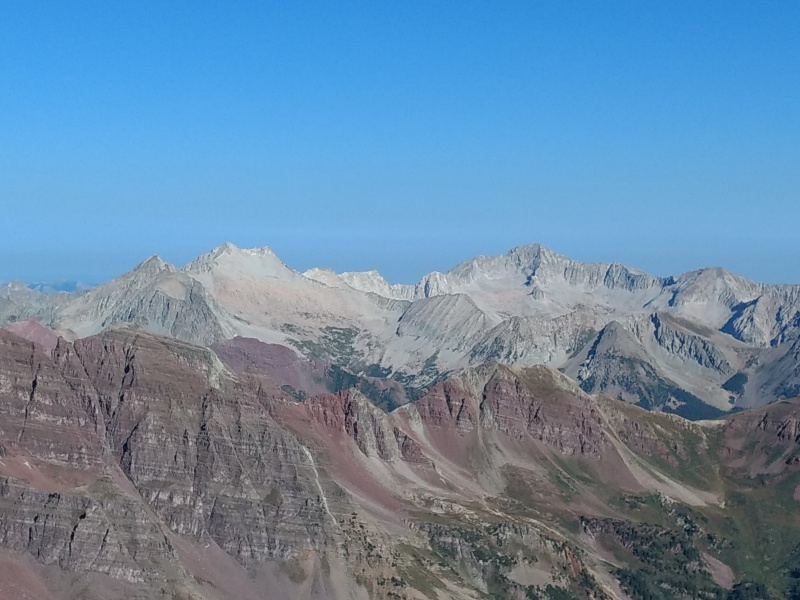 Views of Snowmass and of Capital with its infamous Knife Edge Times: 2:45am start 2:50am get lost in the parking lots (are you freakin kidding me?! How can you get lost at Maroon Bells?? I’m glad nobody’s watching…) 4:42am entering Amphitheatre 5:42am almost to base of 1k climb 6:42am on top of ridge after taking very sketchy right hand “shortcut.” 7:10am spent a while catching selfies at the Leap of Faith/Ledges and taking a breather. 7:30am start up the green wall (actually went a little to the climber's right which wasn’t the best path). 8:25am summit 9:07am start down 12:26pm back at the parking lot |
| Comments or Questions |
|---|
|
|
Caution: The information contained in this report may not be accurate and should not be the only resource used in preparation for your climb. Failure to have the necessary experience, physical conditioning, supplies or equipment can result in injury or death. 14ers.com and the author(s) of this report provide no warranties, either express or implied, that the information provided is accurate or reliable. By using the information provided, you agree to indemnify and hold harmless 14ers.com and the report author(s) with respect to any claims and demands against them, including any attorney fees and expenses. Please read the 14ers.com Safety and Disclaimer pages for more information.
Please respect private property: 14ers.com supports the rights of private landowners to determine how and by whom their land will be used. In Colorado, it is your responsibility to determine if land is private and to obtain the appropriate permission before entering the property.
